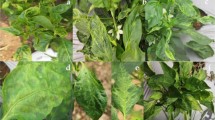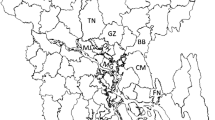Abstract
Chilli (Capsicum annuum L.) is an important vegetable crop grown in the Indian sub-continent and is prone to viral infections under field conditions. During the field survey, leaf samples from chilli plants showing typical symptoms of disease caused by cucumber mosaic virus (CMV) such as mild mosaic, mottling and leaf distortion were collected. DAC-ELISA analysis confirmed the presence of CMV in 71 out of 100 samples, indicating its widespread prevalence in the region. Five CMV isolates, named Gu1, Gu2, BA, Ho, and Sal were mechanically inoculated onto cucumber and Nicotiana glutinosa plants to study their virulence. Inoculated plants expressed the characteristic symptoms of CMV such as chlorotic spots followed by mild mosaic and leaf distortion. Complete genomes of the five CMV isolates were amplified, cloned, and sequenced, revealing RNA1, RNA2, and RNA3 sequences with 3358, 3045, and 2220 nucleotides, respectively. Phylogenetic analysis classified the isolates as belonging to the CMV-IB subgroup, distinguishing them from subgroup IA and II CMV isolates. Recombination analysis showed intra and interspecific recombination in all the three RNA segments of these isolates. In silico protein–protein docking approach was used to decipher the mechanism behind the production of mosaic symptoms during the CMV-host interaction in 13 host plants. Analysis revealed that the production of mosaic symptoms could be due to the interaction between the coat protein (CP) of CMV and chloroplast ferredoxin proteins. Further, in silico prediction was validated in 13 host plants of CMV by mechanical sap inoculation. Twelve host plants produced systemic symptoms viz., chlorotic spot, chlorotic ringspot, chlorotic local lesion, mosaic and mild mosaic and one host plant, Solanum lycopersicum produced mosaic followed by shoestring symptoms.






Similar content being viewed by others
Data availability
The nucleotide accession IDs (GenBank IDs) of all the five isolates under study are available publicly in NCBI with following accession IDs: RNA1: Gu1 (MN340987), Gu2 (MN340993), BA (MN340990), Sal (MN340998), Ho (MN340996) RNA2: Gu1 (MN340988), Gu2 (MN340994), BA (MN340991), Sal (MN3410000), Ho (MN340997) RNA3: Gu1 (MN340989), Gu2 (MN340995), BA (MN340992), Sal (MN3410001), Ho (MN340998)
References
Baspinar A, Cukuroglu E, Nussinov R, Keskin O, Gursoy A (2014) PRISM: a web server and repository for prediction of protein–protein interactions and modeling their 3D complexes. Nucleic Acids Res 42(W1):W285–W289
Bonnet J, Fraile A, Sacristán S, Malpica JM, García-Arenal F (2005) Role of recombination in the evolution of natural populations of cucumber mosaic virus, a tripartite RNA plant virus. Virology 332(1):359–368
Biovia (2017) Biovia Workbook, Release 2017; BIOVIA Pipeline Pilot, Release 2017
Comeau SR, Gatchell DW, Vajda S, Camacho CJ (2004) ClusPro: an automated docking and discrimination method for the prediction of protein complexes. Bioinformatics 20(1):45–50
Daróczi G (2013) Saves: Fast load variables. R package version 0.5. http://cran.r-project.org/package=saves
DeLano (2009) The PyMOL Molecular Graphics System. https://pymol.org/2/
Doolittle SP (1916) A new infectious mosaic disease of cucumber. Phytopathology 6(2):145–147
FAO (2022) World food and agriculture-statistical yearbook (https://www.fao.org/documents/card/en/c/cc2211en)
Galtier N, Gouy M, Gautier C (1996) SEAVIEW and PHYLO_WIN: two graphic tools for sequence alignment and molecular phylogeny. Bioinformatics 12(6):543–548
García-Arenal PFP (2003) Cucumoviruses. Adv Virus Res 62:241–323
Gasteiger E, Gattiker A, Hoogland C, Ivanyi I, Appel RD, Bairoch A (2003) ExPASy: the proteomics server for in-depth protein knowledge and analysis. Nucleic Acids Res 31(13):3784–3788
Guruprasad K, Reddy BVB, Pandit MW (1990) Correlation between stability of a protein and its dipeptide composition: a novel approach for predicting in vivo stability of a protein from its primary sequence. Protein Eng Des Sel 4(2):155–161
Hall T, Biosciences I, Carlsbad CJGBB (2011) BioEdit: an important software for molecular biology. GERF Bull Biosci 2(1):60–61
Hareesh PS, Madhubala R, Bhat AI (2006) Characterization of cucumber mosaic virus infecting Indian long pepper (Piper longum L.) and betel vine (Piper betle L.) in India. Indian J Biotechnol 5:89–93
Hobbs HA, Reddy DVR, Rajeshwari R, Reddy AS (1987) Use of direct antigen coating and protein a coating ELISA procedures. Plant Dis 71(8):747–749
Jacquemond M (2012) Cucumber mosaic virus. Adv Virus Res 84:439–504
Kaur S, Kang SS, Sharma A, Sharma S (2014) First report of pepper mottle virus infecting chilli pepper in India. New Dis Rep 30(14):2044–0588
Khan SM, Raj SK, Bano T, Garg VK (2006) Incidence and management of mosaic and leaf curl diseases in cultivars of chilli (Capsicum annuum). J Food Agric Environ 4(1):171
Kim M-K, Jeong R-D, Kwak H-R, Lee S-H, Kim J-S, Kim K-H, Cha B, Choi H-S (2014) First report of cucumber mosaic virus isolated from Wild Vigna angularis var. nipponensis in Korea. Plant Pathol J 30(2):200
Krishnareddy M, Rani RU, Kumar KSA, Reddy KM, Pappu HR (2008) Capsicum chlorosis virus (Genus Tospovirus) infecting chili pepper (Capsicum annuum) in India. Plant Dis 92(10):1469–1469
Kumar S, Gautam KK, Raj SK (2015) Sequence analysis and genetic diversity of five new Indian isolates of cucumber mosaic virus. Acta Virol 59(4):398–404
Kumar S, Stecher G, Li M, Knyaz C, Tamura K (2018) MEGA X: molecular evolutionary genetics analysis across computing platforms. Mol Biol Evol 35(6):1547
Kumari R, Bhardwaj P, Singh L, Zaidi AA, Hallan V (2013) Biological and molecular characterization of cucumber mosaic virus subgroup II isolate causing severe mosaic in cucumber. Indian J Virol 24(1):27–34
Lee GR, Won J, Heo L, Seok C (2019) GalaxyRefine2: simultaneous refinement of inaccurate local regions and overall protein structure. Nucleic Acids Res 47(W1):W451–W455
Martin DP, Murrell B, Golden M, Khoosal A, Muhire B (2015) RDP4: detection and analysis of recombination patterns in virus genomes. Virus Evol. https://doi.org/10.1093/ve/vev003
Nagendran K, Priyanka R, Aravintharaj R, Balaji CG, Prashant S, Basavaraj B, Mohankumar S, Karthikeyan G (2018) Characterization of cucumber mosaic virus infecting snake gourd and bottle gourd in India. Physiolo Mol Plant Pathol 103:102–106
Nouri S, Arevalo R, Falk BW, Groves RL (2014) Genetic structure and molecular variability of cucumber mosaic virus isolates in the United States. PLoS ONE 9(5):e96582
Owen J, Palukaitis P (1988) Characterization of cucumber mosaic virus I. Molecular heterogeneity mapping of RNA 3 in eight CMV strains. Virology 166(2):495–502
Palukaitis P, Roossinck MJ, Dietzgen RG, Francki RIB (1992) Cucumber mosaic virus. Adv Virus Res 41:281–348
Pavithra BS, Govin K, Renuka HM, Krishnareddy M, Jalali S, Samuel DK, Himabindu K (2019) Characterization of cucumber mosaic virus infecting coleus (Plectranthus barbatus) in Karnataka. Virus Dis 30(3):403–412
Qiu Y, Zhang Y, Wang C, Lei R, Wu Y, Li X, Zhu S (2018) cucumber mosaic virus coat protein induces the development of chlorotic symptoms through interacting with the chloroplast ferredoxin I protein. Sci Rep 8(1):1–11
Raj SK, Chandra G, Singh BP (1997) Some Indian strains of cucumber mosaic virus (CMV) lacking satellite RNA. Indian J Exp Biol 35(10):1128–1131
Raj SK, Kumar S, Pratap D, Vishnoi R, Snehi SK (2007) Natural Occurrence of cucumber mosaic virus on Rauvolfia serpentina, a new record. Plant Dis 91(3):322–322
Raj SK, Kumar S, Snehi SK, Pathre U (2008) First report of cucumber mosaic virus on Jatropha curcas in India. Plant Dis 92(1):171–171
Roossinck MJ (2002) Evolutionary history of cucumber mosaic virus deduced by phylogenetic analyses. J Virol 76(7):3382–3387
Roossinck MJ, Zhang L, Hellwald K-H (1999) Rearrangements in the 5′ nontranslated region and phylogenetic analyses of cucumber mosaic virus RNA 3 indicate radial evolution of three subgroups. J Virol 73(8):6752–6758
Samad A, Raj SK, Srivastava A, Chandra G, Ajayakumar PV, Zaim M, Singh BP (2000) Characterization of an Indian isolate of cucumber mosaic virus infecting Egyptian henbane (Hyoscyamus muticus L.). Acta Virol 44(3):131–136
Samad A, Ajayakumar PV, Gupta MK, Shukla AK, Darokar MP, Somkuwar B, Alam M (2008) Natural infection of periwinkle (Catharanthus roseus) with cucumber mosaic virus, subgroup IB. Austral Plant Dis Notes 3(1):30–34
Sanabam R, Chanu N, Sharma SK, Roy SS, Ansari MA, Prakash N (2018) Genetic diversity of chilli veinal mottle virus infecting different chilli landraces in North East India indicates the possibility of transboundary movement of virus. 3 Biotech 8(8):1–7
Senanayake D, Mandal B, Lodha S, Varma A (2007) First report of chilli leaf curl virus affecting chilli in India. Plant Pathol 56(2):343
Srivastava A, Raj SK (2004) High molecular similarity among Indian isolates of cucumber mosaic virus suggests a common origin. Curr Sci 87:1126–1131
Srivastava KM, Raj SK, Singh BP (1992) Properties of a cucumber mosaic virus strain naturally infecting chrysanthemum in India. Plant Dis 76:474
Swapna Geetanjali A, Kumar R, Srivastava PS, Mandal B (2011) Biological and molecular characterization of two distinct tomato strains of cucumber mosaic virus based on complete RNA-3 genome and subgroup specific diagnosis. Indian J Virol 22(2):117–126
Thompson JD, Gibson TJ, Plewniak F, Jeanmougin F, Higgins DG (1997) The CLUSTAL_X windows interface: flexible strategies for multiple sequence alignment aided by quality analysis tools. Nucleic Acids Res 25(24):4876–4882
Verma N, Singh AK, Singh L, Kulshreshtha S, Raikhy G, Hallan V, Ram R, Zaidi AA (2004) Occurrence of cucumber mosaic virus in Gerbera jamesonii in India. Plant Dis 88(10):1161–1161
Verma N, Mahinghara BK, Ram R, Zaidi AA (2006) Coat protein sequence shows that cucumber mosaic virus isolate from geraniums (Pelargonium spp.) belongs to subgroup II. J Biosci 31(1):47–54
Vinodhini J, Rajendran L, Abirami R, Karthikeyan G (2021) Co-existence of chlorosis inducing strain of cucumber mosaic virus with tospoviruses on hot pepper (Capsicum annuum) in India. Sci Rep 11(1):1–9
Vishnoi R, Kumar S, Raj SK (2013) Molecular characterization of a cucumber mosaic virus isolate associated with mosaic disease of banana in India. Phytoparasitica 41(5):545–555
Wahyuni WS, Dietzgen RG, Hanada K, Francki RIB (1992) Serological and biological variation between and within subgroup I and II strains of cucumber mosaic virus. Plant Pathol 41(3):282–297
Waterhouse A, Bertoni M, Bienert S, Studer G, Tauriello G, Gumienny R, Heer FT, de Beer TAP, Rempfer C, Bordoli L (2018) SWISS-MODEL: homology modelling of protein structures and complexes. Nucleic Acids Res 46(W1):W296–W303
Yang J, Zhang Y (2015) Protein structure and function prediction using I-TASSER. Curr Protoc Bioinform 52(1):5–8
Yugandhar K, Gromiha MM (2014) Protein–protein binding affinity prediction from amino acid sequence. Bioinformatics 30(24):3583–3589
Acknowledgements
This work was carried out with financial support from Department of Science Technology-Science and Engineering Research Board (DST-SERB, Grant no. YSS/2015/001449), Government of India through funding the project entitled “Understanding molecular mechanisms of Capsicum annuum L. and cucumber mosaic virus interaction through transcriptomics” University of Agricultural Sciences, GKVK, Bangalore.
Author information
Authors and Affiliations
Contributions
HDV carried out the overall work, SH, MN, MM helped in conducting the experiments. SH, VV, JCR, PSK and KSS helped in bioinformatics analysis, MR provided the materials for conducting an experiment. CNLR and MKR conceptualized the work, provided the overall guidance and funding.
Corresponding authors
Ethics declarations
Conflict of interest
The authors declare that they have no conflict of interests.
Research involving human participants and/or animals
This article does not contain any studies with human participants or animals performed by any of the authors.
Informed consent
Informed consent was obtained from all individual participants included in the study.
Supplementary Information
Below is the link to the electronic supplementary material.
Rights and permissions
Springer Nature or its licensor (e.g. a society or other partner) holds exclusive rights to this article under a publishing agreement with the author(s) or other rightsholder(s); author self-archiving of the accepted manuscript version of this article is solely governed by the terms of such publishing agreement and applicable law.
About this article
Cite this article
Vinaykumar, H.D., Hiremath, S., Nandan, M. et al. Genome sequencing of cucumber mosaic virus (CMV) isolates infecting chilli and its interaction with host ferredoxin protein of different host for causing mosaic symptoms. 3 Biotech 13, 361 (2023). https://doi.org/10.1007/s13205-023-03777-8
Received:
Accepted:
Published:
DOI: https://doi.org/10.1007/s13205-023-03777-8




